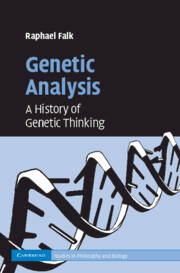Book contents
- Frontmatter
- Contents
- List of figures
- Acknowledgments
- Introduction
- PART I FROM REPRODUCTION AND GENERATION TO HEREDITY
- 1 The biologization of inheritance
- 2 Mendel: the design of an experiment
- PART II FAKTOREN IN SEARCH OF MEANING
- PART III THE CHROMOSOME THEORY OF INHERITANCE
- PART IV GENES AS THE ATOMS OF HEREDITY
- PART V INCREASING RESOLVING POWER
- PART VI DEDUCING GENES FROM TRAITS, INDUCING TRAITS FROM GENES
- PART VII WHAT IS TRUE FOR E. COLI IS NOT TRUE FOR THE ELEPHANT
- Concluding comments
- Bibliography
- Index
1 - The biologization of inheritance
Published online by Cambridge University Press: 07 August 2009
- Frontmatter
- Contents
- List of figures
- Acknowledgments
- Introduction
- PART I FROM REPRODUCTION AND GENERATION TO HEREDITY
- 1 The biologization of inheritance
- 2 Mendel: the design of an experiment
- PART II FAKTOREN IN SEARCH OF MEANING
- PART III THE CHROMOSOME THEORY OF INHERITANCE
- PART IV GENES AS THE ATOMS OF HEREDITY
- PART V INCREASING RESOLVING POWER
- PART VI DEDUCING GENES FROM TRAITS, INDUCING TRAITS FROM GENES
- PART VII WHAT IS TRUE FOR E. COLI IS NOT TRUE FOR THE ELEPHANT
- Concluding comments
- Bibliography
- Index
Summary
Similarity and variation among living creatures has long been a mystery that has stimulated the classification and organization of life into hierarchical systems, as well as the induction of the differential ranking of individuals in society. Variation and similarity also provided the material for one of the most basic ancient unfolding developments of human culture, animal and plant breeding. The first chapter of Genesis beautifully reflects the ancients' conception of the hierarchical, as well as anthropocentric, catalog of the universe:
In the beginning God created the heavens and the earth … Then God said, “Let the land produce vegetation: seed-bearing plants and trees on the land that bear fruit with seed in it, according to their various kinds.” And … the land produced vegetation: plants bearing seed according to their kinds and trees bearing fruit with seed in it according to their kinds. … And God said, “Let the land produce living creatures according to their kinds: livestock, creatures that move along the ground, and wild animals, each according to its kind.” … Then God said, “Let us make man in our image, in our likeness, and let them rule over the fish of the sea and the birds of the air, over the livestock, over all the earth, and over all the creatures that move along the ground.”
Genesis 1, 1–26Animals and plants were believed to have been generated by God as distinct kinds at the time of Creation, and it was reproduction that maintained the link of similarity in living creatures.
- Type
- Chapter
- Information
- Genetic AnalysisA History of Genetic Thinking, pp. 14 - 24Publisher: Cambridge University PressPrint publication year: 2009



